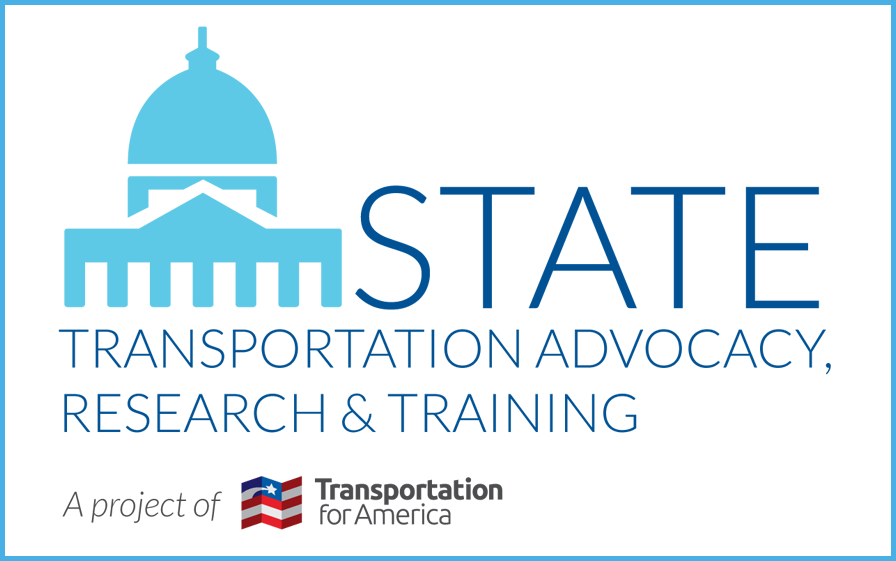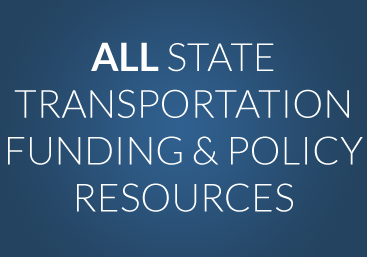Browse the report
POLICY GOALS
- I: Increase accountability and transparency to build taxpayer confidence
- II: Make states economically competitive; empower locals to do the same
- III: Invest in innovation and reward the smartest projects
- IV: Maximize savings through better project development
- V: Improve safety through better street design
Download the full report (pdf)
Join the START Network
T4America supports efforts to produce and pass state legislation to increase transportation funding, advance innovation and policy reform, empower local leaders and ensure accountability and transparency. Join the network.
State policy & funding home
Click here to visit our central hub for all state policy and funding resources, including our work tracking proposals in states to raise new transportation funding or reform the policies governing those funds to improve how those dollars are spent.
Stay informed
Sign up to receive news and updates from T4America. All fields are required.
Goal V: Improve safety through better street design
OVERVIEW
Too many roads are designed only for speeding cars or, worse, creeping traffic jams. As a result, we limit access and opportunity for Americans without a car and stifle the economic potential of in-demand mixed-use, multimodal communities. States should provide flexibility (and incentives) to ensure that streets are designed and built to be safer for all users and magnets for strong economic growth.
PROPOSAL #11
INCENTIVIZE COMMUNITIES TO IMPLEMENT COMPLETE STREETS POLICIES
A complete streets approach attempts to make a street safe, comfortable and convenient for all users, regardless of age, especially in communities where people live, work, and attend school.
Though 33 states had complete street policies on the books at the start of 2016, many of the states that have adopted these policies have witnessed slow implementation and adoption of complete street design principles — sidewalks, bike lanes, crosswalks, etc. — in the actual designs of new or reconstructed roadways.
The State of Massachusetts leads the country in supporting complete streets by establishing a funding program to encourage municipalities to regularly and routinely include complete streets design elements and infrastructure on locally-funded roads . This program, the first of its kind in the country, encourages municipalities to adopt complete streets policies, allocates $12.5 million for the first two years of the program, and plans to accept its first applications for funding early-2016. Funding source and amount beyond FY17 will be determined based on the success of the program.
The Massachusetts Department of Transportation (MassDOT) has adapted its policy and scoring guidance from the models provided by the National Complete Streets Coalition and Smart Growth America. The Complete Streets Funding Program includes two primary requirements that deem a municipality eligible for up to $50,000 for technical assistance, and up to $400,000 for construction funding. Those requirements are a) the passage of a complete streets policy that scores 80 or above (out of a possible 100 points), and b) the development of a Complete Streets Prioritization Plan that must include needs assessments, network gap analysis, investment strategy, procedures to incorporate complete street projects into routine road work and goals for non-auto commuting trips. Upon completion of these requirements, a municipality is eligible for complete street construction funds.
PROPOSAL #12
ADOPT MORE FLEXIBLE STREET DESIGN STANDARDS
Everyone, regardless of age, ability, income, race, or ethnicity, ought to have safe, comfortable, and convenient access to community destinations and public places — whether walking, driving, bicycling, or taking public transportation. A low hanging fruit available to many states is the adoption of design manuals that enable more livable communities through complete streets development.
The National Association of City Transportation Officials — a group made up of big-city transportation officials who understand the unique needs of streets in heavily urbanized areas — produced a ready-made, off-the-shelf multimodal design guide that states should endorse. NACTO’s Urban Street Design Guide provides states a clear outline and tools for developing complete streets that are more inclusive for all users. USDOT has endorsed this guide, as have California, Colorado, Delaware, Georgia, Massachusetts, Minnesota, Oregon, Tennessee, Utah, Virginia and Washington. (California, Colorado, Delaware, Georgia, Massachusetts, Oregon, Virginia and Washington also endorsed the companion Urban Bikeway Design Guide.
NACTO is producing a forthcoming Transit Street Design Guide to provide advice for street designs that best serve public transportation, helping to complete their suite of design guides for our roads.







